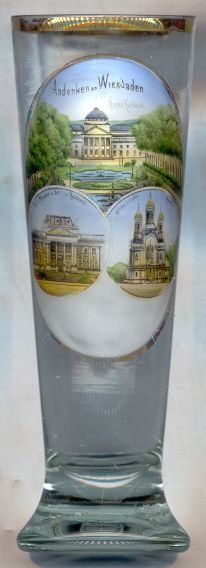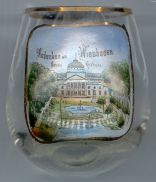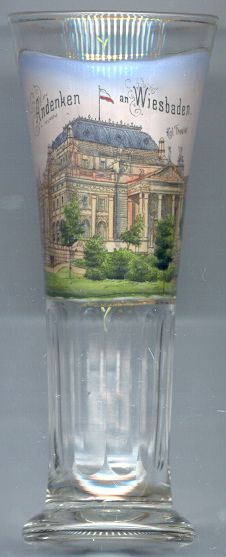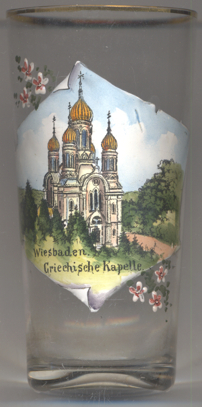

|
| DEUTSCHLAND | GERMANY |
| Bundesland: Hessen | Hesse |
| Regierungsbezirk: Darmstadt | |
| Stadt: Wiesbaden |
Wiesbaden is situated at an elevation of 182 m on the right bank of the river Rhine. The Romans built a fort at this place between AD 6 and 15.
Soon after that, the thermal springs, known to the Romans as Aquae Mattiacorum, were expanded and a civil settlement
was founded. Around Ad 370 this settlement was fortified. The Romans were superseded by Alemanni at the end of the 4th century,
followed by the Franks about a century later. In 1828/830, Wisabada was first mentioned in a document. At that time it
was a royal residence. SInce the late Middle Ages, Wiesbaden was the residence of the counts of Nassau. During the early 13th century,
the town had the status of an Imperial city for a short period until it was destroyed by the archbishops of Mainz in 1242.
Destroyed by fires in 1547 and 1561, and during the Thirty Years' War (1618–1648), Wiesbaden only had about 730 inhabitants in 1690.
In 1744, the Prince Karl of Nassau-Usingen built his residence at Biebrich; Wiesbaden became the seat of the government of the principality
of Nassau, which was elevated to the rank of a Duchy in 1806. During the 19th century Wiesbaden became one of the most popular international
spas in Europe, and retained this position also after the annexation of Nassau by Prussia in 1866. Since 1945 it is the capital of Germany's state of Hessen.


The  Neues Kurhaus [left, no. 1297: top picture; and right, no. 1430] was built by the architect Friedrich von Thiersch in 1902–1907
in place of an earlier building of 1807–1810. The Kurhaus was heavily damaged in 1945. After extensive and careful renovations based
on the original appearance of 1907, the Kurhaus was reopened in 1987.
Neues Kurhaus [left, no. 1297: top picture; and right, no. 1430] was built by the architect Friedrich von Thiersch in 1902–1907
in place of an earlier building of 1807–1810. The Kurhaus was heavily damaged in 1945. After extensive and careful renovations based
on the original appearance of 1907, the Kurhaus was reopened in 1987.

The  Staatstheater Wiesbaden (Hessisches Staatstheater)
[far left, no. 1297: bottom left picture, and near left, no. 1610],
originally named Königliches Theater, was built in Neo-Baroque style 1892–1894 by the architects Ferdinand Fellner and Hermann Helmer.
The Neo-Rococo foyer was added in 1902. The picture on the glass shows the back side of the theatre facing the park Warmer Damm.
Staatstheater Wiesbaden (Hessisches Staatstheater)
[far left, no. 1297: bottom left picture, and near left, no. 1610],
originally named Königliches Theater, was built in Neo-Baroque style 1892–1894 by the architects Ferdinand Fellner and Hermann Helmer.
The Neo-Rococo foyer was added in 1902. The picture on the glass shows the back side of the theatre facing the park Warmer Damm.
(See also list of further buildings by Fellner and Helmer that are depicted on glasses of this collection.)
The  monument for Friedrich Schiller [left, no. 1297: bottom left picture: foreground, barely visible] was erected
in 1905 on the occasion of the 100th anniversary of Schiller's death.
monument for Friedrich Schiller [left, no. 1297: bottom left picture: foreground, barely visible] was erected
in 1905 on the occasion of the 100th anniversary of Schiller's death.
 The
The  Russian Orthodox Church of Saint Elizabeth
[far left, no. 1297: bottom right picture, and near left, no. 3493] was built in 1847–1855
in Russian Byzantine style for the first wife of Duke Adolf of Nassau, Grand Duchess Elisabeth Michailovna, and her child who had died
one day after childbirth. Until today, the church is used by the Russian-Orthodox community of Wiesbaden.
Russian Orthodox Church of Saint Elizabeth
[far left, no. 1297: bottom right picture, and near left, no. 3493] was built in 1847–1855
in Russian Byzantine style for the first wife of Duke Adolf of Nassau, Grand Duchess Elisabeth Michailovna, and her child who had died
one day after childbirth. Until today, the church is used by the Russian-Orthodox community of Wiesbaden.
![[scale]](lineal.jpg)